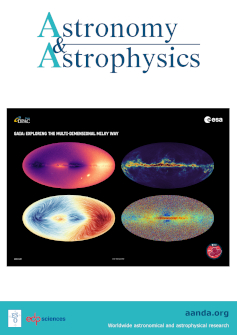A neural network approach to determining photometric metallicities of M-type dwarf stars
IF 5.4
2区 物理与天体物理
Q1 ASTRONOMY & ASTROPHYSICS
引用次数: 0
Abstract
Context. M dwarfs are the most abundant stars in the Galaxy and serve as key targets for stellar and exoplanetary studies. It is particularly challenging to determine their metallicities because their spectra are complex. For this reason, several authors have focused on photometric estimates of the M-dwarf metallicity. Although artificial neural networks have been used in the framework of modern astrophysics, their application to a photometric metallicity estimate for M dwarfs remains unexplored.Aims. We develop an accurate method for estimating the photometric metallicities of M dwarfs using artificial neural networks to address the limitations of traditional empirical approaches.Methods. We trained a neural network on a dataset of M dwarfs with spectroscopically derived metallicities. We used eight absolute magnitudes in the visible and infrared from Gaia, 2MASS, and WISE as input features. Batch normalization and dropout regularization stabilized the training and prevented overfitting. We applied the Monte Carlo dropout technique to obtain more robust predictions.Results. The neural network demonstrated a strong performance in estimating photometric metallicities for M dwarfs in the range of −0.45 ≤ [Fe/H] ≤ +0.45 dex and for spectral types as late as M5.0 V. On the test sample, the predictions showed uncertainties down to 0.08 dex. This surpasses the accuracy of previous methods. We further validated our results using an additional sample of 46 M dwarfs in wide binary systems with FGK-type primary stars with well-defined metallicities and achieved an excellent predictive performance that surpassed the 0.1 dex error threshold.Conclusions. This study introduces a machine-learning-based framework for estimating the photometric metallicities of M dwarfs and provides a scalable data-driven solution for analyzing large photometric surveys. The results outline the potential of artificial neural networks to enhance the determination of stellar parameters, and they offer promising prospects for future applications.测定m型矮星光度金属丰度的神经网络方法
上下文。M矮星是银河系中最丰富的恒星,是恒星和系外行星研究的关键目标。确定它们的金属丰度尤其具有挑战性,因为它们的光谱很复杂。由于这个原因,一些作者把注意力集中在m矮星金属丰度的光度估计上。尽管人工神经网络已被用于现代天体物理学的框架中,但它们在M矮星光度金属丰度估计中的应用仍未得到探索。为了解决传统经验方法的局限性,我们开发了一种利用人工神经网络准确估计M矮星光度金属丰度的方法。我们在光谱衍生金属丰度的M矮星数据集上训练了一个神经网络。我们使用了来自盖亚、2MASS和WISE的8个可见光和红外绝对星等作为输入特征。批归一化和dropout正则化稳定了训练并防止了过拟合。我们应用蒙特卡罗dropout技术来获得更稳健的预测结果。该神经网络在估算M矮星- 0.45≤[Fe/H]≤+0.45指数范围内以及M5.0 V光谱类型的光度金属丰度方面表现出很强的性能。在测试样本上,预测的不确定性降至0.08指数。这超过了以往方法的准确性。我们使用46个M矮星样本进一步验证了我们的结果,这些样本来自具有明确金属丰度的fgk型主星的宽双星系统,并取得了超过0.1指数误差阈值的出色预测性能。本研究引入了一个基于机器学习的框架来估计M矮星的光度金属丰度,并为分析大型光度调查提供了一个可扩展的数据驱动解决方案。这些结果概述了人工神经网络在增强恒星参数测定方面的潜力,并为未来的应用提供了良好的前景。
本文章由计算机程序翻译,如有差异,请以英文原文为准。
求助全文
约1分钟内获得全文
求助全文
来源期刊

Astronomy & Astrophysics
地学天文-天文与天体物理
CiteScore
10.20
自引率
27.70%
发文量
2105
审稿时长
1-2 weeks
期刊介绍:
Astronomy & Astrophysics is an international Journal that publishes papers on all aspects of astronomy and astrophysics (theoretical, observational, and instrumental) independently of the techniques used to obtain the results.
 求助内容:
求助内容: 应助结果提醒方式:
应助结果提醒方式:


